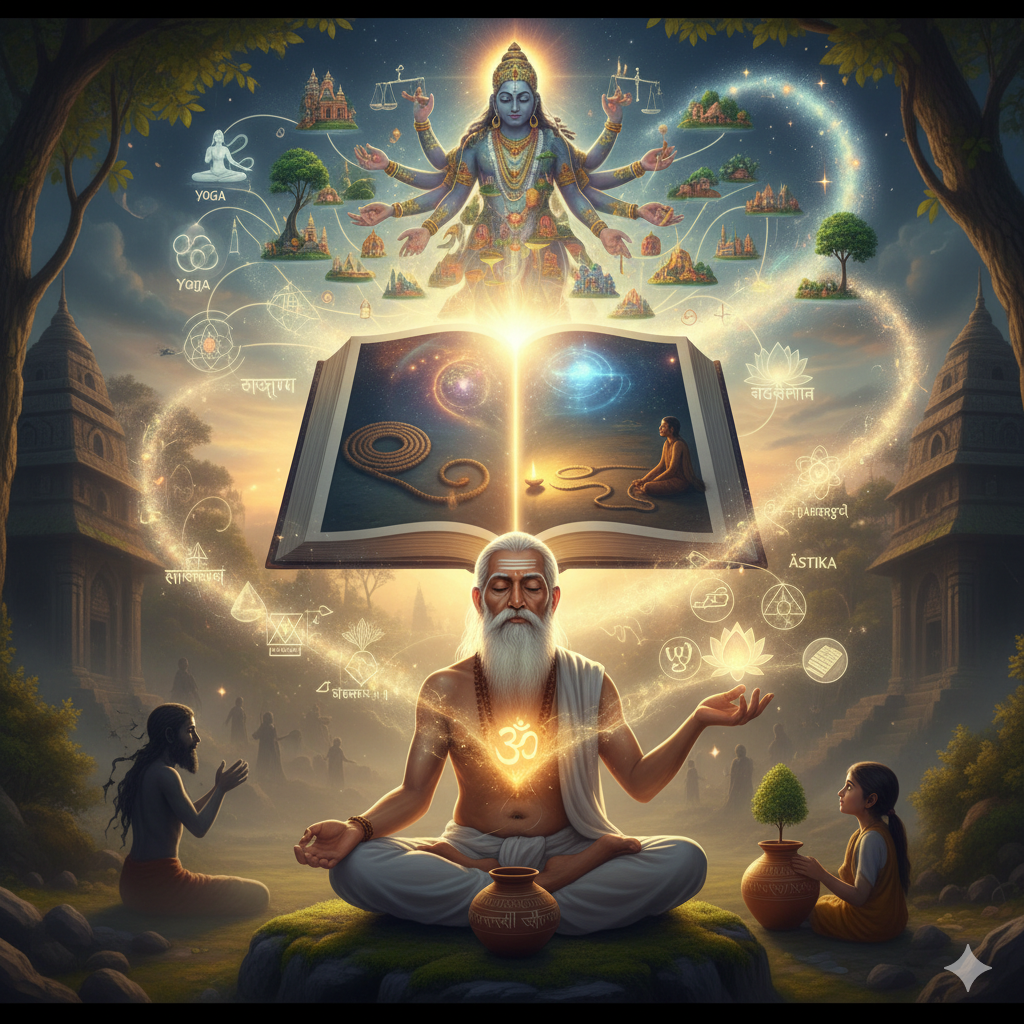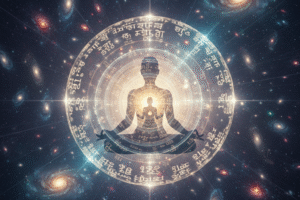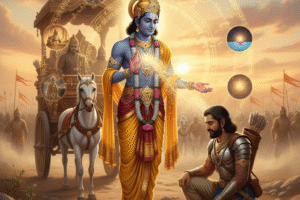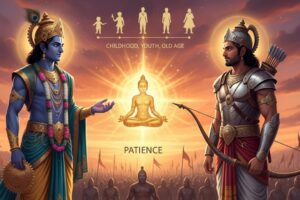
How to experience the all-pervading Atman,Different levels of reality
- Posted by Sri Kameswari Foundation
- Date October 3, 2025
- Comments 0 comment
Let us begin our exploration of the concepts covered in this episode with a question:
We may know in theory that the Ātman (the Soul) is all-pervading, but how can we truly experience it?
To understand this,we turn to the Darśanas.A Darśana literally means “a way of seeing” or “a perspective.” Our Ṛṣis gave six major Darśanas,each offering an interpretation of creation, the nature of the jīva, the purpose of life, and the path to attain it. While they differ slightly in emphasis,together they form a rich framework of understanding.
The names are familiar to many: Yoga,Sāṅkhya,Nyāya,Vaiśeṣika,Mīmāṃsā and Vedānta.
Alongside these,there are also Nāstika Darśanas. This brings us to an important distinction—Āstika and Nāstika.
- Āstikas are those who accept the authority of the Vedas and live by their guidance. They believe in karma siddhānta (the law of action and result) and in the continuity of existence beyond this life.As the saying goes: Asti paro lokaḥ iti ye manyante te āstikāḥ—those who believe in higher worlds and the ongoing journey of the jīva are called Āstikas.
- Nāstikas, on the other hand, deny the existence of higher worlds or continuity of life.For them,only this single life exists—Nāsti paro lokaḥ iti ye manyante te nāstikāḥ.
Now,through which Darśana should we approach the Bhagavadgītā?
The Gītā is part of the Prasthāna-traya—the three foundational texts of Vedānta. It belongs to the Smṛti-prasthāna and is considered one of the greatest Vedāntic works given to us by Vyāsa Maharṣi, alongside other profound texts like the Ṛbhu Gītā, Aṣṭāvakra Gītā, and Sanatsujātiya etc.
So,the question of experiencing the all-pervading Ātman is to be understood through Vedānta. Just as we answer a child in language that they can grasp,Vedānta explains these truths in ways our intellect can comprehend.
Different levels of reality
According to Vedānta,before creation there existed only one reality—Chaitanyam(Consciousness).
But then arises the question: If only one existed,why do I now see so many things?
Vedānta explains this through the doctrine of Māyā, often illustrated with the example of rajju-sarpa bhrānti (mistaking a rope for a snake).In dim light, a timid person may see a rope and imagine it to be a snake,reacting with fear.Yet,if reason is applied,fear dissolves.Similarly, our perceptions of multiplicity arise from ignorance.Correct understanding requires intellect,not just emotion.
This example also shows that there are different levels of reality:
- Prātibhāsika satta (apparent reality,like dreams or illusions).
- Vyāvahārika satta (empirical reality,our day-to-day functional world).
- Pāramārthika satta (absolute reality,the standpoint of Brahman/Ātman).
A child may accept a friend’s words as absolutely true.As we grow,we learn to test claims,weigh evidence, and seek truth more carefully.We accept all our life experiences as true until we begin to question the source of our cognition.
Dreams are real while they last,but upon waking,we realize their limited nature.Similarly,our worldly experiences are valid at a certain level (vyāvahārika),but Vedānta directs us to recognize the higher pāramārthika reality—the omnipresence of Paramātma.
How do we experience this omnipresence?
- Through the senses (indriyas).
- Through inference (anumāna).
- Through analogy (upamāna).
- Through testimony of śāstra (śabda).
The direct experience is possible only for human beings—because of the unique faculty of manas (the mind).When someone asks, “How are you?”, our mind instantly responds with a sense of “I.” This I-ness (aham) is the very key that connects the individual self to the infinite Self. The more we expand our identity from the limited self to the universal Self, the closer we come to Paramātma.
This is what the lives of yogis demonstrate.Their example shows us how to align the mind with the Supreme,purify the heart (citta-śuddhi), and see the divine presence in all actions.
Another method is reasoning through cause and effect.Wherever there is an effect,there must be a cause.A child may see a pot but not recognize that it is made of clay, as their understanding of clay is limited. But one who grasps the logic of cause and effect recognizes that just as clay pervades the pot, Paramātma pervades all forms.
Finally,we rely on śabda pramāṇa—the wisdom of scriptures like the Bhagavadgītā and Rāmāyaṇa, gifted to us by the Ṛṣis.
Thus,while Paramātma pervades everything, Vedānta helps us understand that you and I are also not separate from that reality.Just as the body is one yet has many limbs,the entire creation is one reality with countless forms.Each of us carries the omnipresence, omniscience, and omnipotence of Paramātma.To realize and experience this truth is the ultimate purpose of life.
This post covers the concepts related to the seventh episode. Please click on the “Ch-2|Meaning of Shlokas 13-14” link in the Śrīmadbhagavadgītā Tattvamu home page to read the meaning,that has been explained in Episode-7.
You can also listen to this in Telugu from our Āchārya,Dr. Jammalamadaka Suryanārāyaṇa garu,by clicking the video below.
You may also like

Pratyabhijna,The Deeper Meaning of Antaha,Atma Tattvam

Ch-2|Meaning of Shlokas 15-17

